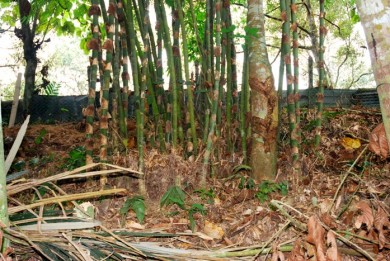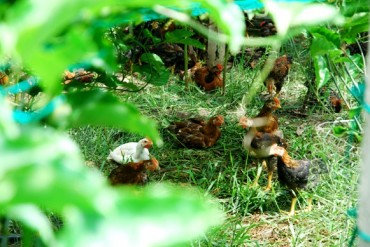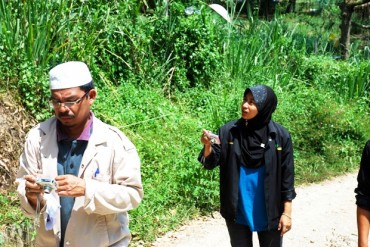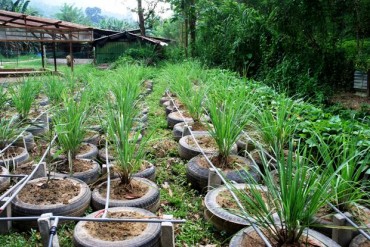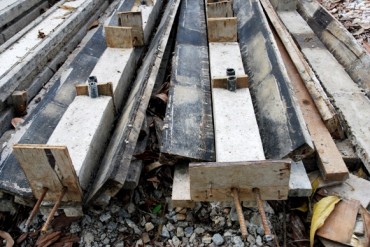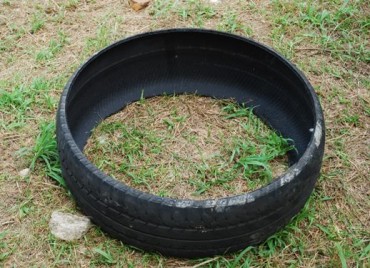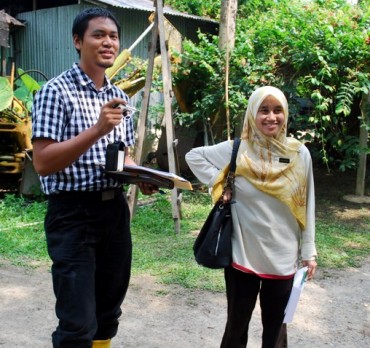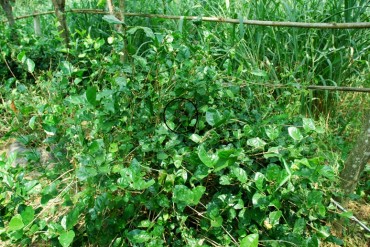Oct 08, 2011
Raising Free Range Chickens - Necropsy & Disease Identification
Being able to perform necropsy of dead chickens and to identify diseases is crucial for the success of a chicken farm.
Delays in disease identification can lead to outbreaks resulting in high mortality and economic losses.
It is absolutely necessary for detail records to be kept from Day 0 until all the chickens are sold, for each batch. Detail records will enable us to analyse out trends and history, which together with the lesions in organs will help identify the many causes of poor weight gain, mortality, etc.
For example, trend analysis enabled us to identify a non-gumboro spiking mortality phenomenon in young chicks below two weeks old, which we ultimately traced to mosquitoes.
Dirgha Bahadur Tamang, from Nepal, has reached competency in necropsy and disease identification.
Dirgha receiving his certificates from Razaly, the farm director
We provide him with a 3 inch thick file of laminated pictures of the key clinical signs of various common chicken diseases. He uses the pictures as a reference and when he sees the start of infectious disease in culled chickens, he will raise the alarm for quick pre-emptive action.
Dirgha with his certificates and his file on common poultry diseases
We hope to be able to sponsor him for further studies to be a vet some time in the future.

Dirgha performing a necropsy on a young chick.
Oct 07, 2011
Spreading The Word II
Certificate in Biochar Production
Bal Bahadur Bishokarma, from Nepal, used to make charcoal for sale at his village using traditional pit methods. Since coming to our farm, he realizes that our methods are less wasteful and involves less physical work. He now knows the importance of planting trees for charcoal production rather than cutting down forest trees.
Here he is receiving his competency certificate from Razaly, the farm director.
At the farm, for each of the planted trees he cuts down for biochar (biochar is charcoal used for soil amendment generally using less 'dense' material) production, he has to plant five.
The tree of choice here at our farm is gliricidia sepium (for biochar) and acacia mangium (for charcoal). They are fast growing and hence are excellent carbon sequesters.
The resultant biochar has multiple uses at our farm. The main use is in the chicken litter to reduce free gaseous ammonia which can cause inflammation in the respiratory tracts of young chicks.
We have done tests at our farm to see if soil amended with biochar versus unamended soil has a difference in productivity. The results show no significant difference. The reason would seem to be that our soil is already very rich in microbial population and was never intensely cultivated. Perhaps in areas with less fertile soil and subject to repeated cultivation, biochar amendment may produce results as per the writings of many advocates.
At the farm, our biochar production is to reduce our carbon footprint by sequestering carbon (CO2) from our animals using fast growing trees. These trees are then used to produce biochar which are used in our poultry and aquaculture operations, and to filter discharge from our farm.
When Bal returns to Nepal, hopefully, he can make a living out of producing biochar and charcoal on a sustainable basis.
15:35 Posted in Biochar, Blog, Chickens | Permalink | Comments (0) | Tags: biochar, charcoal, ammonia reduction in chicken litter, pyrolysis, gliricidia sepium, acacia mangium, biochar production
Sep 14, 2011
The Earth Provides…
At the farm, we leave many of the original plants alone. And as you walk, you will find food almost everywhere – bamboos, banana piths, banana hearts and more.
Here's a clump of bamboo in our farm, which we can see growing wild alongside highways, in secondary forests, along village trails:
Here's some shoots we cut off from just such a clump.
Remove the outer bark and cut into thin slices.
Soak overnight, then replace the water with new water and bring to a boil. These steps will reduce or eliminate the bitter taste of the shoots.
Throw away the water and it is ready for making a gourmet dish.
Here are the main ingredients –

Turmeric, small onions (shallots), garlic, chillies, pound them together.
Make coconut milk from grated coconut meat.
Add serai (lemongrass), turmeric leaves and limau purut (kaffir lime) leaves and the pounded ingredients.
Put all the ingredients in the milk together and bring to a boil. Then add the bamboo shoot slices and prawns, salt and traditionally, some sugar, to taste.

Seriously yummy; the crunchiness of the shoots offset the tender prawns to make a delicious texture-filled, aromatic dish.
18:11 Posted in Blog, Permaculture, Slow Food / Rare Receipes | Permalink | Comments (0) | Tags: rebung masak lemak, bamboo shoots, slow food
Sep 10, 2011
Lynas - What's It All About?
We are in Pahang, so we should be concerned.
Below we pasted an article lifted from http://www.loyarburok.com.
You should click the link below to read the comments as they provide views opposed to that of the writer:
http://www.loyarburok.com/2011/09/06/understanding-lynas-rare-earth-plant-13-questions/
Then you make up your own mind.
Understanding the Lynas Rare Earth plant in 13 questions
6 September 2011 | Green-World | Posted by Tan Sze Ming
I’m just a layman, I read the paper I saw the news, but I want to know more…

Q1: What is rare earth (RE)?
Rare earth (RE) is just a metal, as ordinary as other metals like iron, silver and gold. The difference between them is we don’t encounter RE in daily life, e.g. you don’t wear RE bracelets, you don’t build the bridge with RE. It’s precious, valuable and essential for many high-tech industries.
Q2: Who is LYNAS?
LYNAS is the owner of the RE mine and Gebeng plant, incorporated and listed in Australia. LYNAS (M) Sdn. Bhd is wholly owned by LYNAS Inc.
Q3: Where does the RE come from? What is it like?
Like other metals, RE is found in ore (rock) in West Australia. The ore is mined, cleaned and crushed into sand or powder form, before being shipped to Kuantan. The journey is about 5000 km. The size of a single grain of powder can be 100 times smaller than the diameter of a strand of hair.
Q4: Why do they take the RE from Australia and process it here?
The official statement said that Australia cannot provide high-skilled manpower, and that Australia cannot supply enough water, acids and natural gas to process RE.
Q5: What do we get in terms of income?
Malaysia offered 12 years tax break to LYNAS, which means they do not pay us anything during the first 12 years of operation. Eventually, all revenue generated here will probably be channeled back to the LYNAS Inc. share holders in Australia, and not to LYNAS (M) Sdn. Bhd.
Q6: What do we get in terms of job opportunities?
Only a total of 350 employees are needed, including expatriate, skilled and unskilled workers. The number of employees in a mid-size supermarket is greater than this.
Q7: What do we get in terms of new world-class technology?
Malaysia is not a traditional, major RE-producing county. Transferring RE processing knowledge to Malaysia does not benefit the country and its people considerably.
Q8: So, what actually do we get?
Save the “jobs created, new technology and sales revenue of chemicals, water and natural gas”, strictly speaking, in the first 12 years – nothing! Except large quantities of waste. To be more precise, 500 cubic meters/hour of waste water, 100,000 cubic meters/hour of waste gas and 280,000 tonnes/year of solid waste.
Q9: Is RE dangerous?
Most RE metals are harmless, but in natural ore RE is normally mixed with the radioactive substances. During the separation process, valuable RE is extracted and exported to US, Europe and Japan, leaving behind harmful substances in Kuantan.
Q10: How dangerous is it?
The radioactive substances release radiation and two major toxic materials – radon gas and lead. Radon is a colorless, odorless toxic gas. When it gets into the human body through inhalation, it can damage cells and cause cancer. As for lead, many years ago petrol gas been changed from leaded to unleaded, as we didn’t want lead to be released to the air through our car exhaust. Lead can harm the nervous system, and cause brain and blood diseases. In short, two key hazards can be found in Gebeng RE plant – the radiation and the toxic materials.
Q11: Where and when can the radiation, radon and lead be found?
The RE raw material (in powder or sand form) arrives at the Kuantan port, then gets transported to Gebeng by truck, where it is unloaded, transferred and processed. Waste gas from chimneys, the waste water disposed into the Balok River, the solid wastes that are stored in Gebeng – possibly in all of the above we can find the radioactive substances, which can emit radiation, radon and lead, wherever and whenever they are present.
Q12: Mr. A lives in Balok, 3km from Gebeng. Mr. B lives in Kuantan, 30km from Gebeng. Mr. C lives in KL, 300km from Gebeng. Can the radioactive materials endanger them?
In short, the answer is NO for all of them if they stay more than 100 metres away from radioactive materials. But, the answer is YES for all three if they consumed these harmful substances, even if they stay hundreds of kilometres away. WHY? The radiation emitted in Gebeng doesn’t travel long distance to harm us, hence if you stand a short distance away from the materials without consuming it, all you will get is a slight radiation. Radon gas and lead in general do not affect our body externally, as we are protected by our skin. However, if these radioactive materials contaminate the solid waste, waste water and waste gas, they will be released to the atmosphere, water streams and eventually the food chain. Once the radioactive materials enter the human body via inhalation, ingestion and wound penetration, the radiation, radon and lead will be released inside the body and these can cause very serious consequences.
Q13: Why did they say that it is safe? Why did they say that the radioactivity is low? Who should I listen to?
You decide who you should listen to! It’s your life, it’s your family, it’s your home. See above to understand why they said the radioactivity is low. The media, authorities and LYNAS have failed to report the consequences of consuming radioactive materials.
The questions were answered by Dr. Lee Chee Hong, Chemical Engineering Expert on Metals.
Here's a Chinese news report of some experts called by the Chinese business community in Pahang to brief the residents on the safety of Rare Earth processing.
11:14 Posted in Blog | Permalink | Comments (0) | Tags: lynas, rare earth plant pahang
Grass Fed Chickens - Some Basic Considerations
Choosing the right breed is important.
In the West, Cornish Crosses ( white feathered broilers) are free-ranged and pastured (grass fed).
In Malaysia, that's not possible. They will die from heat-stroke.
Many in Malaysia choose the Kabir ( a Sasso-type chicken) to free-range. Like the Cornish Crosses, the Kabir too, have very high metabolic rates and they will easily succumb to our mid-day sun without adequate shade and drinking water that is cooler than ambient.
Also, with their high metabolic rates, they need continuous feeding of high calorie feed. This defeats the purpose of pasturing as they will just sit around eating the feed pellets rather than forage. The omega 6: omega 3 ratio will be high, as they eat mainly the grain-based pellets. Health-wise to the consumer, it makes no difference whether these chickens are raised in a house or free-ranged. They will not and cannot be successfully grass fed. True grass fed chickens can never reach 2.5kg and above in weight. To grow to that size, they need a high calorie feed from grains and fats, which grasses cannot provide ( chickens are not cows and goats and cannot absorb the nutrients in grasses adequately like ruminants can).
Our tests have shown that Cornish Crosses and Kabir (Sasso) will have omega 6: omega 3 ratios as high as 40:1 and above if fed corn-based pellets ad-libitum even though raised on grass fields.
At our farm, we use mainly crosses from our traditional ayam kampung.
Ayam kampung will range whereas Cornish Crosses and Kabir will sit around
Providing sufficient space for the chickens to roam and for the land to recover fast is crucial. Our experience shows that we need a minimum of 25 sq ft of free roaming land for each chicken (factory farms provide 0.75 sq ft per chicken). Depending on the local conditions, this requirement may go up to as high as 50 sq ft of land per chicken. With sufficient space, the grasses can recover during the time the chickens are in the fields as we move them from one end of the field to the other.
So, two factors are involved here. One is the chickens must be moved along, and two the local soil conditions must allow the grasses to recover within the time that the chickens are in the field. In Malaysia we are lucky that our fields are easily 20 times more productive in terms of grass growth than many Western countries. The soil at our farm can count up to 60 to 100 earthworms per cubic feet. That's something Western farmers will die for!
Here are short clips taken from our hand phone. Note that the chickens are already market size and yet the fields are still green. In many farms when the chickens are at market size, the fields will be bare and smelly - that's perhaps one of the tests you as consumers can use to determine whether the chickens are truly grassfed.
Note how well these chickens make use of the space given to them by foraging and eating the grasses and plants.
10:13 Posted in Blog, Chickens | Permalink | Comments (0) | Tags: grass fed chicken, pastured chicken, free-range chicken, organic chicken, omega 6: omega 3 ratio, omega 3, dha, ayam kampung, cornish crosses, kabir, sasso
Aug 03, 2011
Free Range Chicken - Natural Sun-Shading I

This Ramadan sure is hot. For the watermelon seller, bad sales surely is not his lot. The chickens listlessly loll. Under the markisa shelters. Aren't we glad we had tolled. These lovely markisa all to enjoy.
Yesterday was 40 celcius. Hot enough for these chickens to drop dead from heat stroke. And we are talking about ayam kampung, tough as nails!
Natural sun shading used in the farm includes these passion-fruit vines and clumps of big-leafed pisang sematu. Remember, bare earth retains and reflects heat. Bare earth patches can be 5 celcius higher than grass covered patches. And all water-lines MUST be protected from the sun.
A friend of mine is running a closed-house farm. He is cursing day-and-night over his energy bills.
Selamat berpuasa.
10:20 Posted in Chickens, Permaculture | Permalink | Comments (1) | Tags: permaculture, free range chickens, sun shading, passion fruit, markisa, ramadan
Jul 26, 2011
Ministry of Agriculture officers came again....
The Ministry of Agriculture came again to take samples for testing.
Under the Food Regulations Act 1985, we are the only farm at the moment allowed to call our durians "Organic" in Malaysia.
We know of people paying RM28 per 'organic' durian fruit. That's not our durians. Our prices are much lower than that.
We know of sellers claiming their 'organic' durians are from Pahang. That's not us, our farm is not fruiting this season. We are 'resting' our trees.
When we sell our fruits, each individual fruit will have a S.O.M. sticker with our farm number which is SOM 04.03.
Sellers and farmers should be aware that labeling or representing your durians as 'organic' means the farm have a S.O.M. certificate, full stop. If you don't have a S.O.M. certificate, you can't represent your durians as 'organic' under the law. The penalty is stiff, a max fine of RM5,000 and or a jail term of 2 years.
Getting S.O.M. certitication is free. Please apply and get certified.
18:41 Posted in Blog, Visitors | Permalink | Comments (0) | Tags: organic durians, sijil organik malaysia, certified organic farm in malaysia, s.o.m., food regulations act 1985, certified organic durians
Jul 05, 2011
Tire Gardening
We are becoming quite an expert in tire gardening.
An old tire garden on soggy clayey soil producing sweet potatoes, and various herbs.
Tire gardens can be used on patches of land that otherwise will not be productive. Tire gardens tend to require less work for weeding and are suited for perennials. The initial hard work mixing the soil and then filling up the tires will pay off in the long run because you need invest less 'running costs' such as weeding, less leaching of nutrients and being a raised bed, less fungal and nematodes problems .
A new ginger garden coming up on a patch of land that has a lot of construction debris.
A serai / ginger / sweet potato garden in a corner with hard soil.
Proper piping reduces the time taken to water the plants. The pipes are raised on self-made concrete legs. We prefer PVC to poly pipes as we do not cement the sections of the pipes so we can dismantle and adjust or remove as needed.
Neat, sturdy, DIY.
It's easy to make the concrete legs:
Knock some used discarded construction plywood together to form moulds.
Newly stripped from the mould
The rebar sticks into the soil to prevent toppling.
Tires need drainage holes otherwise the roots will rot:
Use a half inch or larger, auger
Drill multiple holes on three sides of the tire
Make sure the holes are clean, otherwise the holes will close with moist soil.
PS
For home gardening, if you want a more aesthetic look, you can do as follows:
Remove the rim using a sharp knife
The tire after the top and bottom rims are removed. You can use it as it is (no necessity for drainage holes), or you may want to reverse it:
We intend to create potato stacks with these; maybe three tires high; the drainage would be better than uncut tires.
19:58 Posted in Blog, Sustainable Farming | Permalink | Comments (0) | Tags: tire gardening, making concrete posts, making drainage holes in tires, uses for old tires
Jun 28, 2011
Organic Certification Auditors Came
Puan Norazlina, Head of the Agricultural Department, Bentong and Mohd Noor Azlan, Malaysian Organic Scheme auditor, together with their support staff, conducted a compliance audit of the farm today.
16:12 Posted in Blog, Visitors | Permalink | Comments (0) | Tags: sijil organik malaysia, som, organic certification malaysia
Jun 26, 2011
They lose all sense of fear....II
You certainly would not expect to find a waterhen nesting right next to a path that's used daily:
Much less, above ground, in a bush. We have always found them on the ground, next to water:
The black circle marks the spot where she's peering at us. Click on pic for larger view
Close up of the wary mother:
Click on pic for larger view
Clutch of six eggs
This can only happen when the mother feels more comfortable nesting near humans than in her natural environment which unfortunately, lately, has more monitor lizards and snakes than usual because of the growing eel population. We are studying how to rebalance the micro-ecology there.
17:13 Posted in Blog | Permalink | Comments (0) | Tags: white crested waterhen, amaurornis phoenicurus, rails, crake













